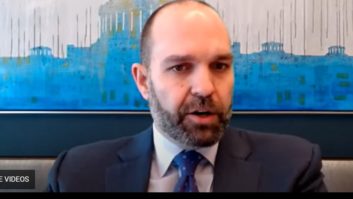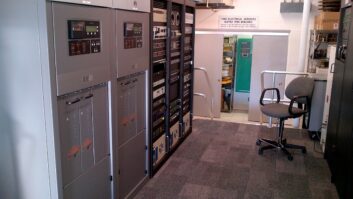
Developers and others involved in hybrid radio have been working to minimize the possible impact of royalty fees that U.S. broadcasters would pay for streamed audio content that is a popular function of hybrid systems for car manufacturers.
A hybrid radio receiver uses a station’s over-the-air signal within the listening area until it is no longer viable, then switches to the station’s online stream via cellular data networks, a feature called “service following” or “station following.” (The listener can choose whether that switchover happens automatically or with a prompt.)
It is an appealing selling point for hybrid radio: The listener stays on the same radio station in a situation when they normally would have switched away. Advocates call this an advantage for both listener and broadcaster — for the first time, terrestrial radio can provide “reception everywhere” akin to what satellite radio can offer.
The technology also can time-align the IP-delivered content to make a full seamless transition between the services, for the best user experience.
In the United States, radio broadcasters that stream their content on the internet or mobile apps must pay for music use on those digital channels; SoundExchange is the entity responsible for collecting digital music recording royalties and distributing them to copyright owners (see sidebar). When the hybrid radio platform is playing the stream, those royalties would kick in.
But broadcasters following these developments had expressed concern about possible additional “hidden” streaming fees if the implementation of hybrid radio samples the stream audio in the background in order to align it with broadcast — meaning broadcasters might incur rights fees even when no one is listening.
Developers like Audi and Xperi, which have separate implementations of hybrid radio, have been working on ways to minimize such royalty exposure.
One observer said he thinks anxiety about this particular potential problem will recede as hybrid becomes more established and the reality of usage becomes more apparent. “I think the bigger risk is that by reacting too adversely to the potential of this risk, it undermines hybrid and accelerates a move to an all-IP environment.”
“Increased engagement”
A number of large radio groups have expressed interest in hybrid radio, and the National Association of Broadcasters has been active in promoting its progress in the United States.
iHeartRadio is collaborating with Audi of America to bring the capability to drivers of connected cars in the United States. Meanwhile in December, Entercom said its Radio.com digital platform is now part of the DTS Connected Radio ecosystem, citing benefits of “increased engagement, expanded reach and turnkey management and control of content for each of our local broadcasters,” according to a press release.
Neither broadcast group commented for this story.
Advocates note that the royalty issue is less of a concern in markets like Germany where broadcast stations do not have to pay additional fees for an online stream if it is an exact simulcast.
But in the United States, a communications attorney familiar with digital media and hybrid radio said limiting exposure to any streaming royalties in connected cars is crucial to support the interest of radio entities.
“Obviously, (broadcasters) won’t want to pay more than necessary. They don’t want to pay for listeners that are not there on the stream. That would be a disincentive for the industry to support hybrid radio,” the attorney said.
“However, broadcasters pay fractions of a cent in streaming royalties, so unless its use becomes widespread, it might not be that much of a financial burden. Much of this will depend on the adoption of the technology and how many use it.”
Two sources involved in these developments emphasized that the time involved in alignment is only a couple of minutes of streaming in the background, and hoped the issue would not discourage other manufacturers from pursuing hybrid radio.
Location-aware
The discussion of sampling in the background to work out alignment for seamless switching is separate from whether streaming should be used at all where good broadcast signal exists.
Some broadcasters have worried that manufacturers would be tempted to put in poor quality radio receivers on the assumption they can freely fall back to streaming in bad reception.
In a 2020 Radio World article, David Layer, VP of advanced engineering for NAB, was quoted saying that a possible solution to such concerns is for broadcasters to provide geographic information to a receiver about where the station’s OTA signal should be strong enough to not require streaming audio.
“The receiver, which is ‘location-aware,’ would not use the streaming signal while within that strong signal area. This would help to reduce the amount of hidden streaming,” Layer said then.
One hybrid radio insider told Radio World that such a process would be like “geo-fencing, in a sense,” though the inverse of the typical application. “Such technology could prevent the stream from even being found within a station’s listening area, so there would be no threat of the hybrid radio receiver tapping into the audio stream unless it is outside the station’s listening area. It creates a barrier.”
However, the person continued, a geo-fencing system might not be able to take into consideration the varied nuances of hybrid receivers in a variety of connected vehicles. “That lack of a unilateral approach to solving the transition process is creating some concern among broadcasters.”
“Only when necessary”
On the alignment issue specifically, one way to limit fees is by maximizing the reception of a radio station’s over-the-air signal.
For instance, Audi — which has been in the forefront of hybrid radio deployment and introduced its first car model with the feature in 2017 — uses multiple FM antennas with the “latest broadcast radio receiver chipsets” to hold the signal stable as long as possible, minimizing situations where streaming is justified. Audi then utilizes an integrated 4G LTE Wi-Fi hotspot to maintain a station’s service when out of range of the signal.
Audi of America has introduced hybrid radio technology on some vehicles available in the United States with the new MIB 3 infotainment suite. With an annual subscription to Audi connect Prime ($365) or Plus ($499), listeners get hybrid radio along with features like Amazon Music integration and a WiFi hotspot.
According to one source, this system can compensate in most cases for up to around 10 seconds of delay in stream vs. the broadcast signal. “When it does not have the time for a perfect alignment, it will switch to stream when the broadcast signal is lost.”
Observers say hybrid receivers have their own unique characteristics and that, ultimately, auto manufacturers will be the ones deciding how seamless the transition from OTA to IP stream is going to be and how often the receivers sample the internet streams.
The amount of delay between OTA and the internet stream can vary, too, depending on connectivity variables built into the receivers. Different latency levels also will develop depending on the cellular network capabilities, such as the delivery speeds of 4G and 5G platforms. And then there is the application infrastructure used by broadcasters for their streams.
“The lower the delay an online stream has compared to the FM signal, the better seamless ‘station following’ works,” the observer said, noting that in the past, broadcasters generally haven’t had to worry about synchronizing the online stream with the OTA signal. “We’ve seen stations in Europe changing their delay to the better after they were introduced to hybrid radio. It’s about awareness.”
“Low-latency”
Xperi’s DTS Connected Radio platform is rolling out in a partnership with Daimler and its luxury Mercedes-Benz passenger vehicles. The technology is part of the Daimler MB User Experience (MBUX) system. The carmaker is including hybrid radio on some Mercedes-Benz S-Class 2021 models that were set to arrive in the United States by the first of the year.
An Xperi official told Radio World some broadcasters supply the company with “custom audio streams” that are more tightly aligned to the over-the-air signal to minimize any streaming delays.
Joe D’Angelo, senior VP of radio at Xperi, said it’s not the company’s practice to use the audio stream in the background to create a seamless time alignment for the hybrid radio environment.
“It will not be totally seamless, but it will be a low-latency switch,” D’Angelo said. “A totally seamless transition could be a very expensive process for broadcasters. We are working with broadcasters to minimize their costs.”
D’Angelo said the issue affects the U.S. and Australian markets because of the structure of streaming royalties there, but that it is less of an issue in Europe.
“We are trying to maximize that radio broadcast signal usage and allow stream access only when it is in the broadcaster’s interest,” he said.
Hybrid radio is basically a collective term for technologies intended to enhance traditional broadcast with an internet connection; and “service following” is not the only benefit.
For instance DTS Connected Radio combines OTA radio with internet-delivered content and aggregates the metadata, such as on-air radio program and talent information and artist and song information. And hybrid radio will offer broadcasters real-time analytics on listening habits and crucial data for advertisers.
But radio broadcasters watch the cost of content closely, D’Angelo said, along with the cost of consumption.
“Those elements need to be considered when designing the system of over-the-air to streaming. With our platform we are very aware of this switch for broadcasters. We have done a lot of engineering work and implementation work to make sure we minimize the time spent streaming while still ensuring a great user experience.
“Our platform is constantly looking at RF signal quality, and then we ensure the switch to streaming only happens when it is absolutely necessary, and we switch back to broadcast as soon as possible. In our system we are literally talking about seconds for the alignment process where it is sampling the IP stream.”
D’Angelo continued: “Car radios all have very different RF performance characteristics. It’s important to consider this nuance to allow you to constantly assess the on-air signal quality.”
He said Xperi research indicates listeners will accept audio in hybrid radio mode that is not totally synced up.
Period of uncertainty
RadioDNS is an open standards organization that promotes technical standards for hybrid systems and encourages sharing of information sharing between broadcasters and manufacturers “to lessen the uncertainty of implementing hybrid radio.” iHeartMedia, Cumulus, Entercom, Cox and NPR are among the members of RadioDNS.
Project Director Nick Piggott said the initial integration phase of hybrid radio does create a period uncertainty for broadcasters since they can’t estimate the amount of extra streaming it creates.
“What I think we can say at this point — taking into account the speed at which vehicles are coming to the market and the number that support seamless switching — [is that] it’s unlikely to have a material impact [on streaming fees] in the short term,” Piggott said.
He said there is “no requirement for auto manufacturers to make hybrid radio seamless,” even though “that seamlessness is a specific approach to the implementation, which of course makes it seem magical to the driver.”
But broadcasters should support manufacturers’ ambitions to provide the audio experience that drivers want, he said.
“The risk of reacting too quickly to this concern is that it pushes manufacturers and drivers towards an all-IP approach, which is certainly less appealing than a hybrid approach.”
sidebar: Royalty Talk
More than 20 years ago the Digital Millennium Copyright Act established the need for radio broadcasters to pay royalties to music performers and record labels for digitally transmitted music.
SoundExchange charges on a per-song, per-listener basis. For each song heard by one listener, radio stations pay $.0018. Broadcasters, which self-report streaming numbers to SoundExchange, pay a minimum fee of $500 per year per digital channel, according to an expert familiar with the royalty payments.
The U.S. Copyright Office announced in 2020 that it would not set 2021 webcasting rates for broadcasters that stream their non-interactive audio programming on the internet until April 15, 2021. Whenever that new rate is established, it is expected to be retroactive to the beginning of the year.
Most radio stations also pay royalties for music they broadcast to organizations like ASCAP, BMI, GMR and SESAC, who reimburse songwriters and their publishers. SoundExchange, performers and record labels have long suggested that broadcasters should also pay royalties to the artists and labels, and have lobbied aggressively to that end.




